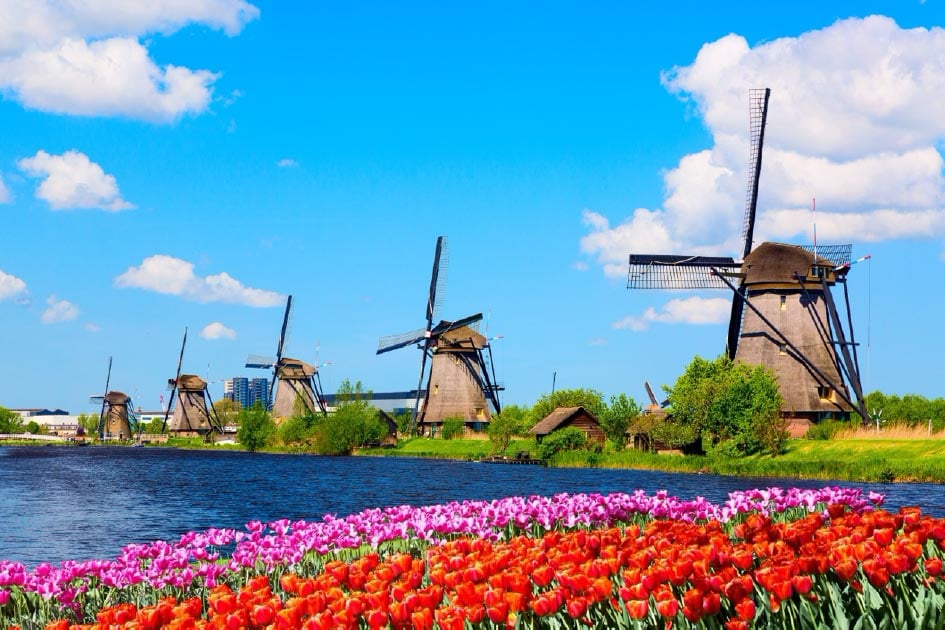Defenders of the Dutch Polders: The Kinderdijk Windmills
The Netherlands is a remarkable society in many ways. Much of the country was once underwater and still remains at risk of being inundated by the sea. The country has developed an ingenious system for keeping the sea at bay, part of which are the Kinderdijk Windmills. These windmills are not only examples of amazing engineering but are also remarkable monuments set in a stunning manmade landscape. These windmills have been a UNESCO World Heritage site since 1997.
The history of the Kinderdijk Windmills
A millennium ago, the area around Kinderdijk was a peat bog only visited by fishermen. However, beginning from the Middle Ages, dikes were used to drain the land and this began to reclaim the bog. In the 13 th century, the local Lord of South Holland set up a board to oversee the drainage of the area. Many dikes were built and over time this area became pastureland. There was a terrible storm that inundated the area and there was widespread loss of life. According to legend, an infant was found alive on a dike and this led to the area being called Kinderdijk (child’s dike). Many believe that this is also the source of the story, Cat in the Cradle.

The windmills, polders and waterways of Alblasserwaard. (jstuij / Adobe Stock)
The Dutch continued with their drainage projects and over time, they managed to reclaim more polders (reclaimed low-lying land) from the sea. However, this was not efficient, and the area was still at risk of flooding. There was a particular problem with differences in water levels. The local authorities decided that they needed to pump water into a local reservoir to protect the polders. In 1738, eight stone windmills were built at the Lek and Noord rivers and in 1740, another eight wooden mills were built. The network of windmills was very successful. However, by the end of the 19 th century, three pumping stations were built and the windmills were no longer used in pumping waters. However, during the German occupation of The Netherlands, the Dutch had to once again rely on windmills to keep the sea at bay. These windmills are still kept in working order in case of another emergency.
What was the purpose of the windmills?
The Kinderdijk Windmills are located in the province of South Holland, which has over 200 windmills. The eight stone windmills are similar to the tower type of windmills. They were built to drain the water from the polders in the Alblasserwaard into a massive reservoir. These windmills are built out of brick, they have windows and are about 100 feet (30 m) high on average. The largest stone windmill in the area is approximately 128 feet high (45m). These windmills are unique because of their size and scale.

Close up of a windmill at Kinderdijk, The Netherlands (Yuichi / Adobe Stock)
The windmills have sails that are made out of wood and canvas and during the windy season can achieve great speeds. These sails are connected to machinery and this allowed the windmills to drain the polders. In general, the wooden windmills are smaller than those made of stone. The windmills were used for the milling of flour and the sawing of timbers for the Dutch shipyards until the late 1800s. The area has many canals, dikes and locks and there is an entire complex water management system to be seen. Near the site, there are two 19 th century power stations and they have been preserved and are still in working order. Adjacent to the windmills is the National Park De Biesbosch, which is a nature park and has many unique plants and animals.
- THE FUTURE OF THE NASHTIFAN WINDMILLS IS BLOWING IN THE WIND
- THE OLD STONES: REMARKABLE DEVELOPMENT OF THE AVEBURY LANDSCAPE
- ADVANCED ENGINEERING DISCOVERED AT THE MAYA OBSERVATORY AT CHICHEN ITZA
How to get there
Visitors can access the area from Rotterdam and Amsterdam by public transport. There is a barge that takes visitors from Rotterdam to the Kinderdijk Windmills. It is possible to visit the windmills all year round. The majority of the windmills cannot be entered and only one is open to the public. Here the public can see a demonstration of traditional milling by a miller. There are a number of events held every year in and around the windmills, including markets. The scenery around Kinderdijk is amazing and there are maps that allow a visitor to explore the area.
Top image: The Kinderdijk Windmills and surrounding waterways during spring, The Netherlands Source: Nikolay N. Antonov / Adobe Stock
By Ed Whelan
References
Zeiler, W. (2018). Architecture and the Sea, the Situation in the Netherlands. In Seaside Building Design: Principles and Practice (pp. 43-63). Springer, Cham < https://link.springer.com/chapter/10.1007/978-3-319-67949-5_4>
Schoorl, F. F. (2005). On authenticity and artificiality in heritage policies in the Netherlands. Museum International, 57(3), 79-85 < https://www.tandfonline.com/doi/abs/10.1111/j.1468-0033.2005.00532.>.
den Boer, A. (2020). Neglected and Undervalued Cultural Heritage: Waterfronts and Riverbanks of Alblasserwaard, The Netherlands. In Adaptive Strategies for Water Heritage (pp. 290-307). Springer, Cham.<https://link.springer.com/chapter/10.1007/978-3-030-00268-8_15>



















